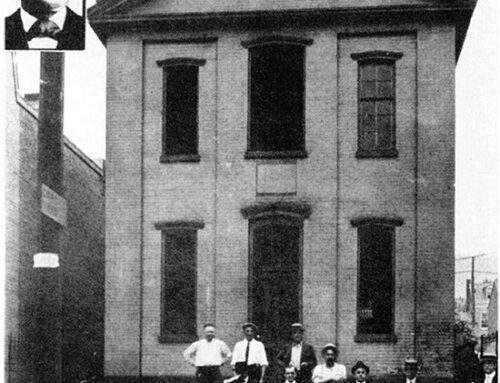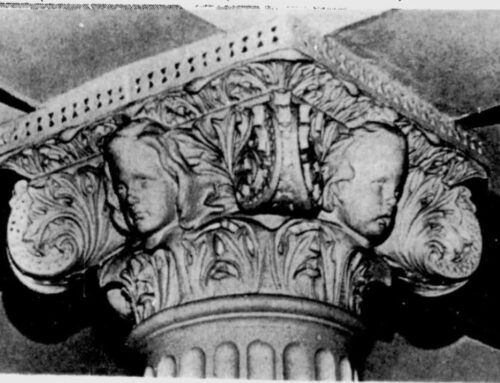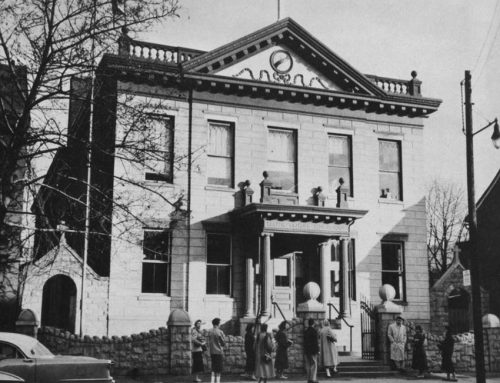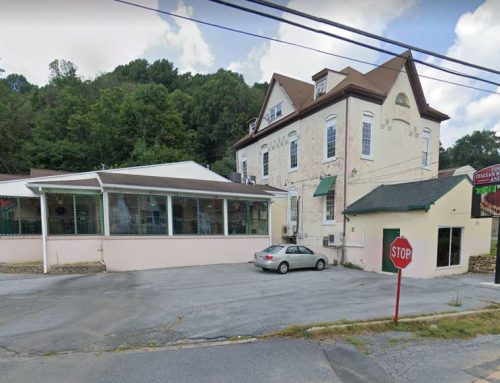In 1927, Rev. Theodore Hammeke, rector of St. Paul’s Church, established St. Paul’s Commercial School as a department of the parochial school. In 1928 Rev. William Hammeke, brother of Fr. Theodore Hammeke, who died that same year from pneumonia, became the new pastor of St. Paul’s Church.
Below: Rev. William Hammeke, founder of Bornemann Memorial Central Catholic High School.

In 1939, after a culmination of many years’ effort, the Rev. William Hammeke, purchased the former “Bon Air” mansion of William H. Luden, at Hill road and Clymer Street, for $45,000, and transformed the former home into a central high school. The mansion was originally offered for sale to the U.S. Treasury Department for $115,000 as a site for a new post office.

Before St. Paul’s Catholic Church on North 9th Street purchased the Luden Mansion for use as a High School the Hawthorne Mansion of George F. Baer at the corner of Mineral Spring Rd. and Clymer St. was offered to the Church for use as the same.
Below: Hawthorne Mansion of George F. Baer, northeast corner of Mineral Spring Rd. and Clymer St.

William Henry Luden (March 5, 1859 in Reading, Pennsylvania – May 8, 1949 in Atlantic City, New Jersey) made his mark on Berks County not only industrially, but architecturally.
Of humble beginnings, Luden amassed considerable wealth through his confectionery business and expended some of it in homes not only in Berks County but in Villanova, Atlantic City, Palm Beach and Miami Beach.
The two mansions he built in Reading still exist.
The first, a Victorian-Romanesque-style brownstone built in 1899, remains at 709 N. Fifth St. in the Centre Park district.
The second was the 40-room mansion Bon-Air mansion. Various accounts of the imposing neoclassical-style limestone edifice, built for a staggering cost of $750,000, list differing dates for its construction.
Rozanne Thompson, former development director of Central Catholic, said school documents states that it was built in 1914. Historian George M. Meiser IX writes that it was completed nearly a decade later, in 1922.
The glorious home featured sweeping views of Reading. Ballrooms, libraries, a basement bowling alley and even a massive pipe organ adorned the Luden home. Servants’ quarters were on the third floor, and the basement had a number of recesses, tunnels and storage areas.
The structure was designed by James Vickson, the architect responsible for other notable buildings including the Reading Public Museum, Temple Oheb Sholem and Wyomissing High School.
The structure is built over a mine shaft which had to be sealed before construction could begin. Iron ore was mined throughout the area, down into City Park and along North 13th Street. The area is permeated with abandoned mine shaft shafts that were closed but never filled in.
The grand marble staircase which lead to the second floor was built over the abandoned mine shaft. Only seniors and faculty could use the marble staircase. Underclassman caught using the staircase had to clean it with a toothbrush as punishment.

The name selected for the new high school was Bornemann Central Catholic High School, in honor of the late Monsignor George Bornemann, who served as rector at St. Paul’s for many years and was noted for his philanthropies to Catholics and Protestants alike. Prior to the opening of Bornemann Catholic High, the high school had been occupying quarters in the school building at St. Paul’s Church, Moss and Walnut streets, of which the Rev. Charles A. Allwein was principal, but only freshman, sophomore and junior classes were conducted.
On September, 3, 1940, Bornemann Catholic High opened, with an enrollment of 75, with freshmen reporting for classes 8:30 o’clock, and the upper classmen, including a senior class, reporting on Wednesday at the same time. The school colors were scarlet and white. The girls wore uniforms of maroon and tan, each class having its distinctive class color on the monogram worn on the dress.
Four courses were offered to students; domestic science, general, academic and commercial courses. Rev. Charles Allwein, principal; three Sisters of Christian Charity and two priests formed the first faculty.
In transforming the former home into a school every effort was taken to preserve the original architecture and lines of the building. The school office was the former dining room. The school library was the former living room. The principal’s office was the former breakfast room. The kitchen became the secretarial Office area and clerical work rooms. The Luden living room became part of the Student library. The Ballroom became a large reading room of the library. Mr. Luden’s private library, located along the Hill Road side of the mansion, became part of the library. A near-by sitting room became the Office of the Vice Principal. The elevator shaft was floored-in at all levels, affording more closet space. The former Billiard room became the Student Chapel named in honor of Pope St. Plus X. The marble stairs, its rug long since removed, and its second floor balcony walled-in with glass brickwork, became the pride and property of each Senior Class, as it was ‘off limits’ to underclassmen. The exterior, which is Italian Renaissance, remains unchanged.
The pipe organ was removed in the Spring of 1964 and relocated in Christ Lutheran Church, Lehigh and Luzerne Streets, Reading, Pa., where it still sounds in all its dignity. The school donated the organ to the church with the condition that the church pay to repair damage to the wooden floor in the library caused by removing the organ. The organ made its debut for Easter service in 1964.
Below: Reading Central Catholic High School Library.

The building contained 44 rooms, all of which were easily adapted to school room purposes with only minor changes. The building is fireproof throughout. The walls are of Indiana limestone and brick. Finished wood floors were laid on heavy reinforced concrete under floors. Because of the nature of the floor and other materials used in building the home, it was possible to remove interior partitions without impairing the original design or safety features.
The second floor was changed to provide five modern classrooms and a girls’ rest room finished in white tile and marble. The rooms were altered to meet all requirements in modern classroom practice. New lighting fixtures were installed to meet all visual standards. Modern blackboards encased in sanitary metal frames were placed in these rooms. All rooms were painted to retain the original beauty and style of the home and each room was treated with a different light pastel shade. Large, roomy cloakrooms were a part of each room. Some of these rooms were retired to serve as storage rooms.
The Luden servant’s quarters of the third floor once housed a Science laboratory, Infirmary, Activities Office, classrooms, and the Audio Visual Office – formerly a large Cedar closet.
The first floor retained its original beautiful appearance. It once included the music room with a $20,000 electric organ, language rooms, library, commercial department rooms, where business equipment was installed, home economics department, biology, laboratory with adjacent lecture rooms, the principal’s office, clothing shop and teachers’ rest rooms.
Below: Former Commercial Department
The basement was converted into storage space and a future chemical laboratory and cafeteria. A boys’ rest room was located in the rear, and a modern heating plant was installed. The third floor remained untouched for future expansion and contained the original bedrooms and bathrooms.
The top floor of the Luden garage housed the Chemistry Laboratory. The Chauffeur’s residence became a Student printing shop, and later in the 1940s the Music Department and Office of the Director of Music.
The Rev. Charles L. Allwein, assistant rector of St. Paul’s Catholic Church from 1932 until the fall of 1939, was the first principal of Central Catholic High. He was the principal of St. Paul’s Commercial School while the late Rev. William Hammake, rector of St. Paul’s parish, negotiated the purchase of the residence of William H. Luden.
Below: Rev. Charles L. Allwein, first principal.

A native of Philadelphia, Father Allwein attended St. Joachim’s Parochial School and St. Joseph’s Prep School in that city before graduating from St. Charles Seminary at Overbrook. He was the first priest ordained in St. Martin’s Church at Overbrook in 1929 by Bishop Gerald F. O’Hara.
After serving a year as chaplain at St. Mary’s Institute for the Blind at Lansdale, Father Allwein went to Bally in June, 1930, where he served as administrator pro tem of the second oldest parish in the diocese of Philadelphia before becoming assistant rector of St. Joseph’s Parish in Easton, in June, 1931. He came to Reading in June, 1932.
On May 16, 1941, the cornerstone was laid for an addition of a $75,000 gymnasium for Bornemann Catholic High, in the presence of the student body of 180 children. Assembling after the noon lunch period, the students watched while the Rev. William Hammeke, rector of St. Paul’s Catholic Church, blessed the stone with holy water. Into the stone went newspaper clippings, pictures of the groundbreaking and other records which were sealed in a copper box.
Below: Cornerstone laying ceremony for new gymnasium.

Below: Construction of gymnasium.

The new addition also contained a cafeteria, locker and shower rooms and nine classrooms. Exterior design of the addition was built to conform with that of the original building with a limestone base.
Below: Reading Central Catholic High School, 1942.

Below: Reading Central Catholic High School Annex.

Below: Reading Central Catholic High School, 1961.

Below: Reading Central Catholic High School Gymnasium.

Below: Reading Central Catholic High School Cafeteria.

In 1947, the school was accredited by the Middle States Association of Colleges and Secondary Schools. The accrediting was based on a three day evaluation conducted in the school by a group of ten educators representing the commission.
Evaluation of the educational institution was made on the basis of the education program, staff, plant and administration. Ratings given by the commission on the school evaluated in comparison with member schools of the association, which include public, private and parochial schools, were as follows: Very superior, superior, average, inferior and very inferior.
Central Catholic High School received a superior rating on curriculum, average on pupil activity, superior on library, superior on guidance, very superior on instruction, very superior on outcomes, very superior on staff, superior on plant, and superior on administration.
In 1947 ground was purchased for an athletic field in neighboring St. Lawrence. The 20-acre complex was located at 3850 St Lawrence Ave in St Lawrence, PA. The land was donated to the school by Dominic Mauer.
Three separate pits for pole vaulting, high jump and broad jump were constructed beside the gridiron. The pole vault pit was excavated and built with a hemlock plank base covered with cinders and sand to provide a cushion effect for jumpers. Permanent rings for the discus and shot put also were also installed. The entire field was enclosed with a cyclone fence, with a California Privet hedge planted inside. Plans called for a seating arrangement of 5,000, with stands constructed of wood and steel on a concrete base.
Prior to the opening of the athletic field, the Cardinals practiced at Pendora Park, and played all their home games in the Albright College Stadium.
Below: Central Catholic High School Athletic Field.


Below: Spectators gathered at first game at new athletic field on September 26th, 1948, in which Central defeated St. Francis Prep 19-6.

In 1952, the Rev. Charles L. Allwein, resigned as principal to become pastor of the Most Blessed Sacrament Catholic Church, at Bally. The Rev. Raymond J. Leichner, director of athletics at the school, took over the reins of principal at the end of the school year, when Father Allwein’s resignation became effective.
A native of Philadelphia, Father Leichner attended Holy Child Parochial School, La Salle High School and Strayers Business College in that city, before attending St Charles Seminary in Overbrook. He was ordained May 29, 1943, in the Cathedral of St. Peter’s and St Paul’s in Philadelphia by the late Dennis Cardinal Dougherty.
Father Leichner came to Reading June 7, 1943, as assistant rector at St. Paul’s Church. He became teacher of religion, moderator of athletics and dean of discipline at Central Catholic in 1944. The following year he took over as athletic director, dean of discipline and boys’ guidance director.
On Sunday, November 30, 1958, the cornerstone was laid for a new convent, at Hill road and Eckert Ave., to house 22 Sisters of Christian Charity teaching to the children of Central Catholic High School. Cardinal John F. O’Hara Philadelphia officiated at cornerstone laying ceremony.
Below: Assumption Convent, Sisters of Christian Charity, Hill Road and Eckert Ave.

The Rev. Raymond J. Leichner, principal of Central Catholic High School, said that inside the cornerstone were these items: A copy of the current issue of the Catholic Standard and Times, weekly newspaper of the Philadelphia archdiocese; copies of the Reading Eagle and Reading Times; a high school handbook; the current issue of the school newspaper, Hillside Echoes; a history of the school; a list of the present faculty, and a list of the officials of the Sisters of Christian Charity.
After the ceremonies, Cardinal O’Hara blessed the two story brick convent, then walked through each of the first floor private rooms for the teaching of Christian Charity, blessing each room individually. Cardinal O’Hara then blessed the crucifixes which would hang in the chapel and in each sister’s room. The final part of the ceremony took place in the chapel, where Cardinal O’Hara officiated at Benediction of the Most Blessed Sacrament.
Assisting at benediction were the Rev, Charles Allwein, co-founder and first principal of the high school and pastor of the Most Blessed Sacrament Parish, Bally, deacon; and Father Leichner, subdeacon.
In 1959, the Sisters moved into the new convent. Previously, the Sisters lived in a stone mansion of 15 rooms and 4 bathrooms located at 1250 Hill Rd. The mansion was built around 1887 by a former Berks Congressman, the late Daniel Ermrntrout, and was purchased on Thursday, July 11, 1957, by the Archdiocese of Philadelphia to be converted into a convent for Sisters of Christian Charity teaching at Central Catholic High School. It once served as the Marshall Home for Convalescent and Elderly People and a private school for children. After expensive alterations, the Sisters moved to their new home. The third floor of the Luden Mansion, where the Sisters resided before relocating, was coverted for school purposes.
In 1964, the Rev. William P. Hoffner became the third principal. That same year Central Catholic High graduated a record size senior class (312). The peak enrollment was 1,200 in 1964. On Sunday, June 7, 1964, more than 2,200 attended the 23rd commencement ceremonies, at the Rajah Theater. The 2,200-seat auditorium and its aisles and stairs were filled with relatives, friends, and onlookers as the 312 senior class members accepted their diplomas.
Holy Name High School opened in the Fall of 1964 to alleviate some of the burden on Central’s population, replace St. Peter’s Reading Catholic High, and expand the catholic school reach in Berks County.
In 1968, the Rev. Joseph J. Morrell became the fourth principal. Morrell was a professor at Nativity Blessed Virgin Mary High School, Pottsville, 1957-64; and vice principal of Allentown Central Catholic, 1964-68.
Improvements to the school were made in 1974, consisting of new stage, physical education and all-purpose room, storage areas, and a TV room. On Thursday, September 26, 1974, a morning assembly was held to kickoff a $60,000 fund drive to pay for the new stage and other improvements.
In 1975, Vincent T. Shemanski became the fifth principal. One of the first lay administrators of Catholic schools; Shemanski taught history and biology and coached football at St. Plus X High School In Roseto, Northampton County, for eight years before accepting a teaching and coaching post at Central Catholic in 1965.
Below: Vincent T. Shemanski, fifth principal.

Mr. Shemanski earned a Bachelors Degree from Kings College, Wilkes Barre, and two Masters Degrees from Lehigh University, Bethlehem.
On September 3, 1976, dedication of new bleachers on the visitors’ side at the athletic field in St. Lawrence, took place before the home football opener against Reading High. The bleachers approximately doubled the seating capacity at the field to nearly 4,000. The home side bleachers were replaced, and the locker room building was expanded in 1969. A new lighting system was installed in 1975.
In 1986 construction began for additions of a physical fitness room, audio-visual room, guidance Suite, teacher’s lounge, storage room, and accounting and student services.
Below: Physical fitness room.

On February 11, 2011, it was announced that Central Catholic would merge with Holy Name high school. The newly formed school would be named Berks Catholic High School located at Holy Name’s site on East Wyomissing Boulevard.
The now vacant building is a monument to Reading’s glory days, a testament to when William Luden put Reading on the map with his candy and cough drop company.
Former Principals:
Rev. Charles Allwein – 1939 – 1952
Rev. Raymond J. Leichner – 1952 – 1964
Rev. William P. Hoffner – 1964 – 1968
Rev. Joseph J. Morrell – 1968 – 1975
Mr. Vincent T. Shemanski – 1975 – 1999
Msgr. Ronald C. Bocian – 1999 – 2001
Mr. Thomas P. Mirabella, M.Ed. – 2001 – 2008
Mrs. Joanne V. Heintz – 2008 – 2011








Leave A Comment